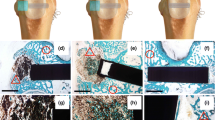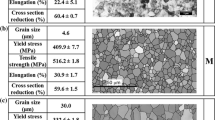Abstract
Intensive work has been performed on the characterization of the mechanical properties of mineralised tissues formed in vivo. However, the mechanical properties of bone-like tissue formed in vitro have rarely been characterised. Most research has either focused on compact cortical bone or cancellous bone, whilst leaving woven bone unaddressed. In this study, bone-like mineralised matrix was produced by osteoblasts cultured in vitro on the surface of titanium alloys. The volume of this tissue-engineered bone is so small that the conventional tensile tests or bending tests are implausible. Therefore, nanoindentation techniques which allow the characterization of the test material from the nanoscale to the microscale were adopted. These reveal the apparent elastic modulus and hardness of the calcospherulite crystals (a representative element for woven bone) are 2.35 ± 0.73 and 0.41 ± 0.15 GPa, respectively. The nanoscale viscoelasticity of such woven bone was further assessed by dynamic indentation analysis.






Similar content being viewed by others
References
Carr BC, Goswami T. Knee implants–review of models and biomechanics. Mater Des. 2009;30:398–413.
Banerjee R, Nag S, Fraser HL. A novel combinatorial approach to the development of beta titanium alloys for orthopaedic implants. Mater Sci Eng C. 2005;25:282–9.
Gallardo-Moreno AM, Pacha-Olivenza MA, Saldana L, Perez-Giraldo C, Bruque JM, Vilaboa N, et al. In vitro biocompatibility and bacterial adhesion of physico-chemically modified Ti6Al4V surface by means of UV irradiation. Acta Biomater. 2009;5:181–92.
Lee HU, Jeong YS, Park SY, Jeong SY, Kim HG, Cho CR. Surface properties and cell response of fluoridated hydroxyapatite/TiO2 coated on Ti substrate. Curr Appl Phys. 2009;9:528–33.
Boivin G, Bala Y, Doublier A, Farlay D, Ste-Marie LG, Meunier PJ, et al. The role of mineralization and organic matrix in the microhardness of bone tissue from controls and osteoporotic patients. Bone. 2008;43:532–8.
Fan Z, Rho JY, Swadener JG. Three-dimensional finite element analysis of the effects of anisotropy on bone mechanical properties measured by nanoindentation. J Mater Res. 2004;19:114–23.
Fan Z, Swadener JG, Rho JY, Roy ME, Pharr GM. Anisotropic properties of human tibial cortical bone as measured by nanoindentation. J Orthoped Res. 2002;4:806–10.
Fan Z, Rho JY. Effects of viscoelasticity and time-dependent plasticity on nanoindentation measurements of human cortical bone. J Biomed Mater Res A. 2002;67:208–14.
Hengsberger S, Enstroem J, Peyrin F, Nuzzo S, Zysset P. How is the indentation modulus of bone tissue related to its macroscopic elastic response? A validation study. J Biomech. 2003;36:1503–9.
Johnson WM, Rapoff AJ. Microindentation in bone: hardness variation with five independent variables. J Mater Sci: Mater Med. 2007;18:591–7.
Mullins LP, Bruzzia MS, McHugha PE. Calibration of a constitutive model for the post-yield behaviour of cortical bone. J Mech Behav Biomed Mater. 2009;2:460–70.
Lewis G, Xu J, Dunne N, Daly C, Orr J. Evaluation of an accelerated aging medium for acrylic bone cement based on analysis of nanoindentation measurements on laboratory-prepared and retrieved specimens. J Biomed Mater Res B–Appl Biomater. 2007;81:544–50.
Oyen ML, Ko CC. Examination of local variations in viscous, elastic, and plastic indentation responses in healing bone. J Mater Sci: Mater Med. 2007;18:623–8.
Oyen ML, Ferguson VL, Bembey AK, Bushby AJ, Boyde A. Composite bounds on the elastic modulus of bone. J Biomech. 2008;41:2585–8.
Rho JY, Tsui TY, Pharr GM. Elastic properties of human cortical and trabecular lamellar bone measured by nanoindentation. Biomaterials. 1997;18:1325–30.
Evans FG. Stress and strain in bone: their relation to fractures and osteogenesis. Springfield, IL: Charles C. Thomas; 1957.
Hing KA, Best SM, Tanner KE, Revell PA, Bonfield W. Biomechanical assessment of bone ingrowth in porous hydroxyapatite. J Mater Sci: Mater Med. 1997;8:731–6.
Currey JD. The mechanical properties of bone. Clin Orthop Relat Res. 1970;73:210–31.
Ascenzi A, Bonucci E, Simkin A. An approach to the mechanical properties of single osteonic lamellae. J Biomech. 1973;6:227–35.
Hainsworth SV, Page TF. Nanoindentation studies of chemomechanical effects in thin-film coated systems. Surf Coat Technol. 1994;68:571–5.
Chen J, Bull SJ. Indentation fracture and toughness assessment for thin optical coatings on glass. J Phys D Appl Phys. 2007;40:5401–17.
Chen J, Bull SJ. The investigation of creep of electroplated Sn and Ni–Sn coating on copper at room temperature by nanoindentation. Surf Coat Technol. 2009;203:1609–17.
Bokhari MA, Akay G, Zhang SG, Birch MA. The enhancement of osteoblast growth and differentiation in vitro on a peptide hydrogely–polyHIPE polymer hybrid material. Biomaterials. 2005;26:5198–208.
Midura RJ, Vasanji A, Su X, Wang A, Midura SB, Gorski JP. Calcospherulites isolated from the mineralization front of bone induce the mineralization of type I collagen. Bone. 2007;41:1005–16.
Warren OL, Wyrobek TJ. Nanomechanical property screening of combinatorial thin-film libraries by nanoindentation. Meas Sci Technol. 2005;16:100–10.
Chen J, Bull SJ. Assessment of the toughness of thin coatings using nanoindentation under displacement control. Thin Solid Films. 2006;494:1–7.
Oliver WC, Pharr GM. An improved technique for determining hardness and elastic modulus using load and displacement sensing indentation experiments. J Mater Res. 1992;7:1564–83.
Syed-Asif SA, Wahl KJ, Colton RJ. Nanoindentation and contact stiffness measurement using force modulation with a capacitive load-displacement transducer. Rev Sci Instrum. 1999;70:2408–13.
Chaudhry B, Ashton H, Muhamed A, Yost M, Bull SJ, Frankel D. Nanoscale viscoelastic properties of an aligned collagen scaffold. J Mater Sci: Mater Med. 2009;20:257–63.
Saruwatari L, Aita H, Butz F, Nakamura HK, Ouyang J, Yang Y, et al. Osteoblasts generate harder, stiffer, and more delamination-resistant mineralized tissue on titanium than on polystyrene, associated with distinct tissue micro–and ultrastructure. J Bone Miner Res. 2005;20:2002–16.
Malzbender J. Comment on “Nanoindentation and whole-bone bending estimates of material properties in bones from senescence accelerated mouse SAMP6”. J Biomech. 2005;38:1191–2.
Comelekoglu U, Bagis S, Yalin S, Ogenler O, Yildiz A, Ozlen-Sahin N, et al. Biomechanical evaluation in osteoporosis: ovariectomized rat model. Clin Rheumatol. 2007;26:380–4.
Leong PL, Morgan EF. Measurement of fracture callus material properties via nanoindentation. Acta Biomater. 2008;4:1569–75.
Georges PC, Miller WJ, Meaney DF, Sawyer ES, Janmey PA. Matrices with compliance comparable to that of brain tissue select neuronal over glial growth in mixed cortical cultures. Biophys J. 2006;90:3012–8.
Engler AJ, Sen S, Sweeney HL, Discher DE. Matrix elasticity directs stem cell lineage specification. Cell. 2006;126:677–89.
Acknowledgment
Wejie and T.Y. Yang are acknowledged for cell culture. Prof. S. Roy is acknowledged for the help of surface analysis of Ti alloy. Mrs. Pauline Carrick at ACMA is acknowledged for the technical assistance of ESEM and EDX.
Author information
Authors and Affiliations
Corresponding author
Rights and permissions
About this article
Cite this article
Chen, J., Birch, M.A. & Bull, S.J. Nanomechanical characterization of tissue engineered bone grown on titanium alloy in vitro. J Mater Sci: Mater Med 21, 277–282 (2010). https://doi.org/10.1007/s10856-009-3843-9
Received:
Accepted:
Published:
Issue Date:
DOI: https://doi.org/10.1007/s10856-009-3843-9




